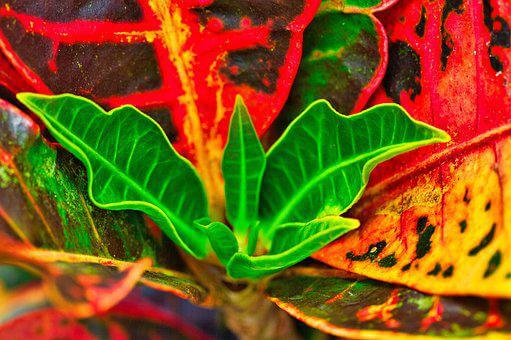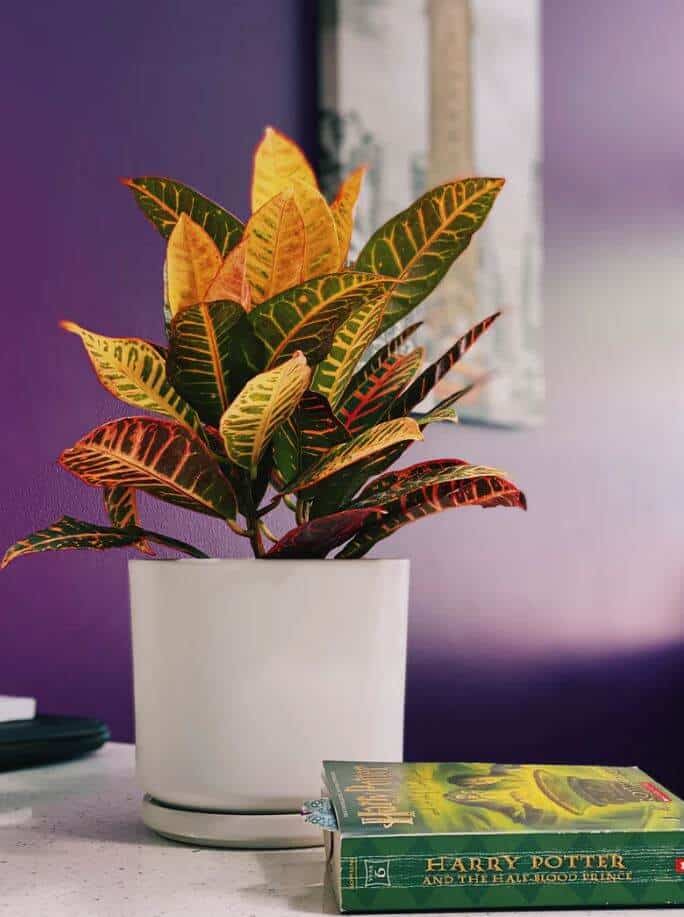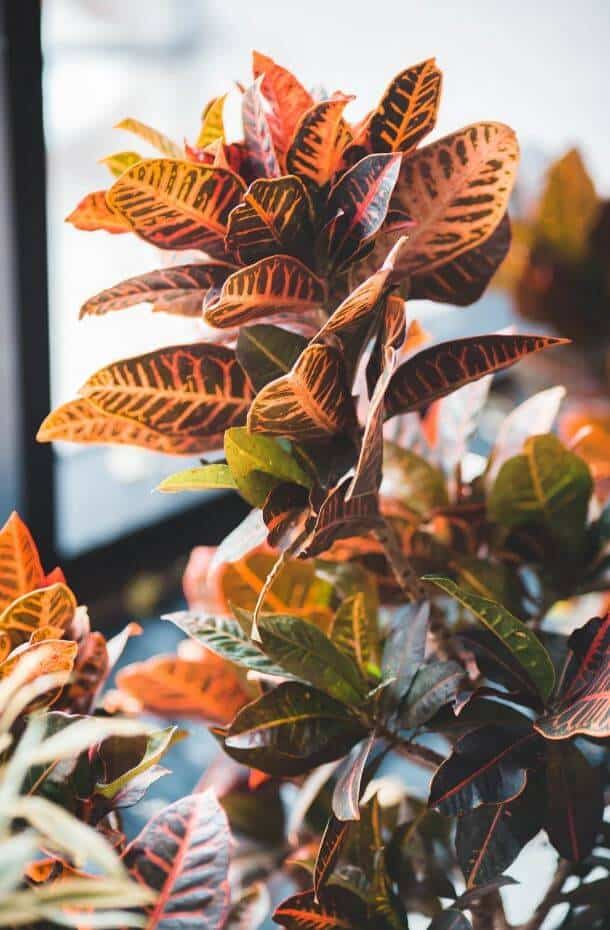Last Updated on January 11, 2023 by a Friendly Gardener
Known botanically as the Codiaeum variegatum, the croton plant belongs to the Euphorbiaceae family. It is a colorful plant with leaves in a variety of shapes and colors including yellow, red, and vivid green that offers an explosion of color wherever it’s located.
The croton is a true diva among houseplants and is not the easiest to care for. With indoor cultivation, it can be quite a challenge. Crotons prefer warm environments with good humidity levels and she is thirsty. The Croton will not weather cold temperatures so if your home is too cold, she will begin to shed leaves.
About the Croton

These perennial shrubs, native to Malaysia and India, are evergreens. In locations like Hawaii, parts of coastal California, and Porto Rico they can be found as ornamental shrubs in outdoor gardens and yards.
Crotonsignifies “tick” in Greek and the name refers to the fact that its seed is shaped like a tick. Foliage boasts a leathery texture, and though it comes in lots of vibrant colors, as the plant matures, leaves may darken to the point to appear black.
Crotons can reach heights of 10 feet outside. Indoor potted houseplants grow to smaller sizes. If your area’s outdoor temperature sits higher than 50° F., you can plant them outside with the correct lighting. Mature plants produce small flowers with star shapes.
The Croton also has enjoyed a practical use as its oil (Croton tiglium), was given as a purgative.
Genetic Instability

A single species, there are nonetheless, lots of varieties. But the Croton suffers from genetic instability, so individual plants are unique. The Croton is often categorized according to the shape of foliage:
- Twisted
- Oval
- Oakleaf
- Narrow
- Curling
- Broad
So, look carefully at the cultivar you select for the shape of its leaves.
Croton Plant Care
Crotons are evergreen perennials and if the plant dies back in winter, the roots will resprout new foliage next spring.
Soil
The Croton requires a well-draining soil bed, so the addition of some peat moss is ideal. The soil must retain moisture without becoming soggy. The ideal soil pH should measure between 4.5 and 6.5.
Light
Light is crucial to Croton’s vivid colors. They need bright indirect light. Direct light should be filtered with a sheer curtain or similar. A lack of proper light will adversely affect the color of the leaves. They may fade.
Water and Humidity
Crotons love and need humidity. In dry conditions, they will be susceptible to spider mite infestation. Mistingyour Croton will help prevent infestation. Mist frequently during Croton’s growing season. Soil beds need to be evenly moist during warmer seasons. When winter arrives, reduce watering to every other week. Overwatering is the principal cause of root rot for this plant. If you forget to water, leaves will wilt or droop. Crotons are not drought tolerant.
Too little humidity also affects foliage color. Plan on 50% to 80%. When humidity is inadequate, leaf drop will commence. To aid your plant, use a space humidifier or a pebble tray placed underneath the plant’s container. Grouping plants together also assists in raising immediate humidity around the plants.
Temperature
When cold, croton will typically drop foliage. The indoor temperature needs to measure above 60° F but not rise above 80°F. Cold and cool drafts will also create problems, so avoid placing them near air vents, drafty windows, doors, or hallways.
Feeding
Crotons prefer a fertilizer that is high in potassium and nitrogen content. Good NPK (nitrogen-phosphorous-potassium) fertilizers might be 3-1-2 or 8-2-10 indicating that the phosphorous content is lower.
Indoor crotons do better with a liquid fertilizer during their growing season. The first feeding should take place at the end of February or the beginning of March. Apply a second feeding in May, and the season’s final feeding in mid-July. Do not feed in the fall to avoid interrupting the croton’s winter preparations.
You can feed regularly by diluting fertilizer to half strength and applying monthly during the growing season.
Pruning
Croton does well with a bit of trimming. For a leggy plant, prune it back as the growing season begins. Move it outdoors if your climate permits. Dead branches and leaves should be pruned to where they begin. Leggy or overgrown branches should be trimmed to just above a leaf node. Never prune more than one-third of a single stem at one time.
Potting or Repotting

Repot your Croton in the spring using a new pot, one size larger than the current container. Fill the new pot with two inches of peat-based moist soil mix. Move your plant gently from its old container. Move it to the new pot and fill it in with potting soil. Water your plant and add in a little more potting soil so that the soil level sits roughly one inch below the pot’s rim. Stop watering when the pot drains from its bottom.
For root-bound plants, separate roots gently with your fingers. If tight, use a sterilized knife to score them.
Outdoor crotons do not do well with frost. Should temperatures drop, cover the plant for frost protection.
Pests, Diseases, and Problems
Should your Croton appear unhealthy, in low-light positions, move it to where it will receive 4 to 5 hours of sunlight daily. Check for drafts, both cold and hot. Check its soil bed for over or underwatering.
Leaf loss happens when a Croton is stressed due to moving, nutrient imbalance, inadequate light, improper temperatures, or insect infestations.
Crotons are susceptible to spiders, mites, scale, mealy bugs, thrips, and the croton caterpillar(Achaea Janata). Use a cotton ball with rubbing alcohol to clean foliage. Another option is two teaspoons of neem oil, one teaspoon of dish soap, and one quart of warm water mixed and generously sprayed on leaves weekly until pests disappear.
The croton caterpillar devours foliage. Continuous applications of neem oil will help. You can also spray BT (Bacillus thuringiensis). BT is non-toxic to pets, humans, and plants.
Diseases include root rot and fungal or bacteria issues usually due to overwatering.
Twisting leaves on a variety that should not twist indicates overfertilization.
Croton Toxicity
The entire croton plant is toxic to pets and humans. Sap will irritate skin irritant, so wear gloves when pruning and removing leaves.
A small amount of Croton ingestion will be moderately toxic causing burning and excessive drooling in pets. When large portions are ingested, intestinal problems may appear with vomiting, diarrhea, stomach pain, and nausea. Pets appear tired, lethargic, and irritable. If your pet vomits, go to your veterinarian asap.
Croton Propagation

Stem cuttings are an easy method of propagation. Dip a cutting in rooting hormone to increase chances of success. These plants often produce sports at the plant base. Remove these and pot them individually. Crotons are not easily propagated from seed.
Cut a section 3 to 4 inches in lengthwith3 to 5 leaves. Dip in rooting hormone and place in a mix of peat moss, vermiculite, and sand. Cover it with plastic to maintain humidity until the roots form. Once roots have formed, transplant your new plant into potting soil. Keep the cutting warm at a temp between 70° to 80°F. Keep soil moist.
The cutting can be cultivated in a glass of water until roots form. Crotons can also be propagated through root division. The division is risky because croton does not like being moved.
Air-layering is another possibility. Cut diagonally approximately halfway into a stem that remains attached to the plant. Introduce rooting hormone into the wound. Keep the cut open using a toothpick. Pack the wound with sphagnum moss and wrap it in plastic wrap. Moss must be kept moist. Should it turn brown, it requires water. Roots will form inside the wound. Once the roots form, cut the stem off and transplant it into a separate pot.
In Conclusion
A Croton will gift you vivid color, brightening any room. It does require best-care conditions for successful indoor cultivation. Bright, indirect light, warm temperatures, and generous humidity reward you with a magnificent explosion of colorful foliage year-round.

